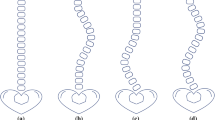Abstract
Purpose
Measurement of vertebral axial rotation (VAR) is relevant for the assessment of scoliosis. Stokes method allows estimating VAR in frontal X-rays from the relative position of the pedicles and the vertebral body. This method requires identifying these landmarks for each vertebral level, which is time-consuming. In this work, a quasi-automated method for pedicle detection and VAR estimation was proposed.
Method
A total of 149 healthy and adolescent idiopathic scoliotic (AIS) subjects were included in this retrospective study. Their frontal X-rays were collected from multiple sites and manually annotated to identify the spinal midline and pedicle positions. Then, an automated pedicle detector was developed based on image analysis, machine learning and fast manual identification of a few landmarks. VARs were calculated using the Stokes method in a validation dataset of 11 healthy (age 6–33 years) and 46 AIS subjects (age 6–16 years, Cobb 10°–46°), both from detected pedicles and those manually annotated to compare them. Sensitivity of pedicle location to the manual inputs was quantified on 20 scoliotic subjects, using 10 perturbed versions of the manual inputs.
Results
Pedicles centers were localized with a precision of 84% and mean difference of 1.2 ± 1.2 mm, when comparing with manual identification. Comparison of VAR values between automated and manual pedicle localization yielded a signed difference of − 0.2 ± 3.4°. The uncertainty on pedicle location was smaller than 2 mm along each image axis.
Conclusion
The proposed method allowed calculating VAR values in frontal radiographs with minimal user intervention and robust quasi-automated pedicle localization.
Graphic abstract
These slides can be retrieved under Electronic Supplementary Material.






Similar content being viewed by others
References
Illés TS, Burkus M, Somoskeőy S et al (2017) The horizontal plane appearances of scoliosis: what information can be obtained from top-view images? Int Orthop. https://doi.org/10.1007/s00264-017-3548-5
Illés TS, Lavaste F, Dubousset JF (2019) The third dimension of scoliosis: the forgotten axial plane. Orthop Traumatol Surg Res 105:351–359. https://doi.org/10.1016/j.otsr.2018.10.021
Humbert L, De Guise JA, Aubert B et al (2009) 3D reconstruction of the spine from biplanar x-rays using parametric models based on transversal and longitudinal inferences. Med Eng Phys 31:681–687. https://doi.org/10.1016/j.medengphy.2009.01.003
Vergari C, Gajny L, Courtois I et al (2019) Quasi-automatic early detection of progressive idiopathic scoliosis from biplanar radiography: a preliminary validation. Eur Spine J. https://doi.org/10.1007/s00586-019-05998-z
Skalli W, Vergari C, Ebermeyer E et al (2017) Early detection of progressive adolescent idiopathic scoliosis. Spine 42:823–830. https://doi.org/10.1097/BRS.0000000000001961
Mainard-Simard L, Lan L, Fort D (2017) The advantages of 3D imagery in diagnosing and supervising children’s and teenagers’ scoliosis. Arch Pédiatr 24:1029–1035 (in French). https://doi.org/10.1016/j.arcped.2017.07.008
Ferrero E, Lafage R, Diebo BG et al (2017) Tridimensional analysis of rotatory subluxation and sagittal spinopelvic alignment in the setting of adult spinal deformity. Spine Deform 5:255–264. https://doi.org/10.1016/j.jspd.2017.01.003
Rehm J, Germann T, Akbar M et al (2017) 3D-modeling of the spine using EOS imaging system: inter-reader reproducibility and reliability. PLoS One 12:e0171258. https://doi.org/10.1371/journal.pone.0171258
Newton PO, Khandwala Y, Bartley CE et al (2016) New EOS imaging protocol allows a substantial reduction in radiation exposure for scoliosis patients. Spine Deform 4:138–144. https://doi.org/10.1016/j.jspd.2015.09.002
Lebel DE, Al-Aubaidi Z, Shin E-J et al (2013) Three dimensional analysis of brace biomechanical efficacy for patients with AIS. Eur Spine J 22:2445–2448. https://doi.org/10.1007/s00586-013-2921-3
Courvoisier A, Garin C, Vialle R, Kohler R (2015) The change on vertebral axial rotation after posterior instrumentation of idiopathic scoliosis. Child Nerv Syst 31:2325–2331. https://doi.org/10.1007/s00381-015-2891-3
Ilharreborde B, Steffen JS, Nectoux E et al (2011) Angle measurement reproducibility using EOS three-dimensional reconstructions in adolescent idiopathic scoliosis treated by posterior instrumentation. Spine 36:E1306–E1313. https://doi.org/10.1097/BRS.0b013e3182293548
Stokes IA, Bigalow LC, Moreland MS (1986) Measurement of axial rotation of vertebrae in scoliosis. Spine 11:213–218
Doré V, Duong L, Cheriet F, Cheriet M (2007) Towards segmentation of pedicles on posteroanterior x-ray views of scoliotic patients. In: Kamel M, Campilho A (eds) Image analysis and recognition: 4th international conference, ICIAR 2007, Montreal, proceedings. Springer, Berlin, pp 1028–1039
Zhang J, Shi X, Wang Y, et al (2010) Snake-based approach for segmenting pedicles in radiographs and its application in three-dimensional vertebrae reconstruction. In: 2010 IEEE international conference on image processing. IEEE, pp 2569–2572
Zhang J, Lou E, Hill DL et al (2010) Computer-aided assessment of scoliosis on posteroanterior radiographs. Med Biol Eng Comput 48:185–195. https://doi.org/10.1007/s11517-009-0556-7
Kumar S, Nayak KP, Hareesh KS (2012) Semiautomatic method for segmenting pedicles in vertebral radiographs. Proc Technol 6:39–48. https://doi.org/10.1016/j.protcy.2012.10.006
Cunha P, Moura DC, Barbosa JG (2012) Pedicle detection in planar radiographs based on image descriptors. In: Campilho A, Kamel M (eds) Image analysis and recognition: 9th international conference, ICIAR 2012, Aveiro, proceedings, part II. Springer, Berlin, pp 278–285
Dalal N, Triggs B (2005) Histograms of oriented gradients for human detection. In: Proceedings—2005 IEEE computer society conference on computer vision and pattern recognition. CVPR, Washington, DC, pp 886–893
Ebrahimi S, Gajny L, Skalli W, Angelini E (2019) Vertebral corners detection on sagittal x-rays based on shape modelling, random forest classifiers and dedicated visual features. Comput Methods Biomech Biomed Eng Imaging Vis 7:132–144. https://doi.org/10.1080/21681163.2018.1463174
André B, Dansereau J, Labelle H (1992) Effect of radiographic landmark identification errors on the accuracy of three-dimensional reconstruction of the human spine. Med Biol Eng Comput 30:569–575. https://doi.org/10.1007/BF02446787
Acknowledgements
The authors are grateful to the ParisTech BiomecAM chair program on subject-specific musculoskeletal modeling for funding (with the support of ParisTech and Yves Cotrel Foundations, Société Générale, Proteor and Covea).
Author information
Authors and Affiliations
Corresponding author
Ethics declarations
Conflict of interest
The authors have no conflicts of interest to declare.
Additional information
Publisher's Note
Springer Nature remains neutral with regard to jurisdictional claims in published maps and institutional affiliations.
Electronic supplementary material
Below is the link to the electronic supplementary material.
Rights and permissions
About this article
Cite this article
Ebrahimi, S., Gajny, L., Vergari, C. et al. Vertebral rotation estimation from frontal X-rays using a quasi-automated pedicle detection method. Eur Spine J 28, 3026–3034 (2019). https://doi.org/10.1007/s00586-019-06158-z
Received:
Revised:
Accepted:
Published:
Issue Date:
DOI: https://doi.org/10.1007/s00586-019-06158-z




